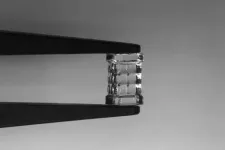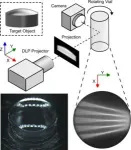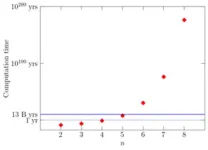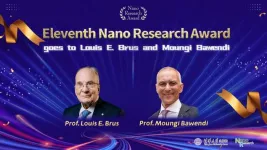(Press-News.org) WASHINGTON — Canadian researchers have developed a new 3D printing method called blurred tomography that can rapidly produce microlenses with commercial-level optical quality. The new method may make it easier and faster to design and fabricate a variety of optical devices.
“We purposely added optical blurring to the beams of light used for this 3D printing method to manufacture precision optical components,” said Daniel Webber from the National Research Council of Canada. “This enables production of optically smooth surfaces.”
In Optica, Optica Publishing Group’s journal for high-impact research, these researchers demonstrate the new method by using it to make a millimeter-sized plano-convex optical lens with an imaging performance similar to a commercially available glass lens. They also show that the method can produce optical components that are ready to use in just 30 minutes.
“We anticipate this method to be valuable for cost-effective and swift prototyping of optical components due to the affordability of the tomographic 3D printer and the materials used,” said Webber. “Also, the inherent freeform nature of tomographic 3D printing could enable optical designers to simplify designs by replacing multiple standard optics with printed optics that have complex shapes.”
Smoothing out the edges
Tomographic volumetric additive manufacturing is a relatively new manufacturing approach that uses projected light to solidify a light-sensitive resin in specific areas. It allows an entire part to be printed at once without any support structures. However, existing tomographic methods cannot directly print imaging-quality lenses because the pencil-like beams used cause striations that lead to small ridges on the component’s surface. Although post-processing steps can be used to create smooth surfaces, these approaches add time and complexity, which takes away the rapid prototyping advantage associated with tomographic printing.
“Fabrication of optical components is costly due to the stringent technical specifications needed for a functioning lens, as well as the complex and time-consuming process of manufacturing,” said Dr. Webber. “Blurred tomography can be used to make freeform designs in a low-cost manner. As the technology matures, it could allow much quicker prototyping for new optical devices, which would be useful for anyone from commercial manufacturers to garage-based inventors.”
Creating tiny lenses
To test the new method, the researchers first created a simple plano-convex lens and showed that it had an imaging resolution comparable to a commercial glass lens with the same physical dimensions. It also exhibited a micron-scale form error, sub-nanometer surface roughness and a point spread function close to the glass lens.
They also made a 3x3 array of microlenses using blurred tomography and compared it to an array printed with conventional tomographic 3D printing. They found that it was not possible to image a business card with the array printed with conventional means due to large surface roughness, but it could be done with the array printed with blurred tomography. Additionally, the researchers demonstrated overprinting of a ball lens onto an optical fiber, which was previously only possible using an additive manufacturing technique known as two-photon polymerization.
They are now working to improve component accuracy by optimizing the light patterning method and by incorporating material parameters into the printing process. They also want to introduce automation of the printing time to make the system sufficiently robust for commercial use.
“Tomographic 3D printing is a rapidly maturing field that is finding use in many application areas,” said Webber. “Here, we leverage the intrinsic advantages of this 3D printing method to fabricate millimeter-sized optical components. In doing so, we have added to the repertoire of optical manufacturing techniques a rapid and low-cost alternative that could potentially have an impact in future technologies.”
Paper: D. Webber, Y. Zhang, K. L. Sampson, M. Picard, T. Lacelle, C. Paquet, J. Boisvert, A. Orth, “Micro-optics Fabrication using Blurred Tomography,” 11, 5 (2024).
DOI: 10.1364/OPTICA.519278.
About Optica
Optica is an open-access journal dedicated to the rapid dissemination of high-impact peer-reviewed research across the entire spectrum of optics and photonics. Published monthly by Optica Publishing Group, the Journal provides a forum for pioneering research to be swiftly accessed by the international community, whether that research is theoretical or experimental, fundamental or applied. Optica maintains a distinguished editorial board of more than 60 associate editors from around the world and is overseen by Editor-in-Chief Prem Kumar, Northwestern University, USA. For more information, visit Optica.
About Optica Publishing Group
Optica Publishing Group is a division of Optica, Advancing Optics and Photonics Worldwide. It publishes the largest collection of peer-reviewed content in optics and photonics, including 18 prestigious journals, the society’s flagship member magazine, and papers from more than 835 conferences, including 6,500+ associated videos. With over 400,000 journal articles, conference papers and videos to search, discover and access, Optica Publishing Group represents the full range of research in the field from around the globe.
END
Researchers harness blurred light to 3D print high quality optical components
New method produces commercial grade microlenses with smooth surfaces, which could advance optical device design
2024-05-09
ELSE PRESS RELEASES FROM THIS DATE:
Older adults with aggressive blood cancer are responsive to treatment and show prolonged survival
2024-05-09
(WASHINGTON, May 9, 2024) – Standard of care treatment for acute myeloid leukemia (AML) is safe and effective for adults over 80, according to a study published in Blood Neoplasia. For roughly a quarter of patients, this treatment can durably prolong survival.
AML is an aggressive and often deadly form of blood cancer that can be difficult to treat. For older adults with AML, the conventional treatment consists of a medication called venetoclax combined with a hypomethylating agent (HMA), also known as VEN-HMA. AML treatment is often intensive and can significantly suppress the immune system ...
Redesigning healthcare: Integrating social care into a safety net health system
2024-05-09
INDIANAPOLIS -- Neighborhoods of high need are where investment in social care offers the best opportunities to improve health. Screening for social determinants of health is comparatively easy, but building the infrastructure to meet needs occurring outside the formal healthcare system is quite difficult. Few health systems have achieved more than even partial integration of social care into routine patient care.
In a case study of pioneering social care provided by Eskenazi Health, a safety net health system located in Indianapolis, ...
Discovery made into which children will outgrow their peanut allergy
2024-05-09
Australian researchers have discovered how changes in antibody levels over time can predict which children are likely to outgrow their peanut allergy.
The research, led by Murdoch Children’s Research Institute (MCRI) in Melbourne and published in Allergy, found two thirds of children with a peanut allergy remain allergic by the age of 10. But for those who did naturally outgrow their allergy, the majority achieved this by six years old.
The study was the first to use antibodies as biomarkers to identify persistent or a resolved ...
Princeton physicists reveal the microscopic basis of a new form of quantum magnetism
2024-05-09
By Tom Garlinghouse for the Princeton University Department of Physics
Not all magnets are the same. When we think of magnetism, we often think of magnets that stick to a refrigerator’s door. For these types of magnets, the electronic interactions that give rise to magnetism have been understood for around a century, since the early days of quantum mechanics. But there are many different forms of magnetism in nature, and scientists are still discovering the mechanisms that drive them.
Now, physicists ...
Oikopleura who? Species identity crisis in the genome community
2024-05-09
When two animals look the same, eat the same, behave the same way, and live in similar environments, one might expect that they belong to the same species.
However, a tiny zooplankton skimming the ocean surfaces of microscopic food particles challenges this assumption. Researchers from Osaka University, University of Barcelona and the Okinawa Institute of Science and Technology (OIST) have analyzed the genome of Oikopleura dioica from the Seto Inland Sea, the Mediterranean, and the Pacific Ocean around the Okinawa Islands, and in doing so, they have raised numerous questions about speciation and the role of gene location in ...
Developed compiler acceleration technology for quantum computers
2024-05-09
[Highlights]
- Developed a new compilation method to generate optimal sequences to be executed on quantum computers
- The new method is based on a probabilistic approach and reduces the time to search for the optimal sequence by several orders of magnitude.
- Expected to contribute to quantum information processing at quantum nodes that support the quantum internet
[Abstract]
The National Institute of Information and Communications Technology (NICT, President: TOKUDA Hideyuki, Ph.D.), RIKEN (President: GONOKAMI Makoto, Ph.D.), Tokyo University of Science (President: Dr. ISHIKAWA Masatoshi), and the University of Tokyo (President: FUJII Teruo, Ph.D.) succeeded ...
Report: Governments falling short on promises of effective biodiversity protection
2024-05-09
WASHINGTON— A new analysis of the world’s largest 100 marine protected areas (MPAs) published today in Conservation Letters suggests that governments are falling short on delivering the promise of effective biodiversity protection due to slow implementation of management strategies and failure to restrict the most impactful activities.
The assessment, titled “Ocean protection quality is lagging behind quantity: Applying a scientific framework to assess real marine protected area progress ...
Study shows how night shift work can raise risk of diabetes, obesity
2024-05-09
Just a few days on a night shift schedule throws off protein rhythms related to blood glucose regulation, energy metabolism and inflammation, processes that can influence the development of chronic metabolic conditions.
The finding, from a study led by scientists at Washington State University and the Pacific Northwest National Laboratory, provides new clues as to why night shift workers are more prone to diabetes, obesity and other metabolic disorders.
“There are processes tied to the master biological clock in our brain that are saying that day ...
Eleventh Nano Research Award goes to Louis E. Brus and Moungi Bawendi
2024-05-09
Recently, Nano Research announced awardees of the 11th Nano Research Award. Two outstanding scientists, Professor Louis E. Brus of Columbia University and Professor Moungi Bawendi of Massachusetts Institute of Technology, have been awarded this honor.
The Nano Research Award, established by the journal Nano Research together with Tsinghua University Press (TUP) and Springer Nature in 2013, aims to recognize outstanding contributions to nano research by an individual scientist. The winner is selected by the Award Committee ...
Traffic injuries to low-income NYC residents fell 30% in first five years of ‘vision zero’ road safety program, NYU study finds
2024-05-09
Among New Yorkers with low incomes, the “Vision Zero” initiative to stem roadway crashes resulted in a marked, 30% reduction in traffic injuries of varying severity from early 2014 – when the city government launched the program – until 2019, according to a new study conducted at New York University.
The study, scheduled for publication May 8 at 4:00 p.m. (ET) in the American Journal of Public Health, revealed this trend of improved safety by comparing Medicaid-covered injury ...
LAST 30 PRESS RELEASES:
Norbert Holtkamp appointed director of Fermi National Accelerator Laboratory
New agentic AI platform accelerates advanced optics design
Biologists discover neurons use physical signals — not electricity — to stabilize communication
Researchers discover that a hormone can access the brain by hitchhiking
University of Oklahoma researcher awarded funding to pursue AI-powered material design
Exploring how the visual system recovers following injury
Support for parents with infants at pediatric check-ups leads to better reading and math skills in elementary school
Kids’ behavioral health is a growing share of family health costs
Day & night: Cancer disrupts the brain’s natural rhythm
COVID-19 vaccination significantly reduces risk to pregnant women and baby
The role of vaccination in maternal and perinatal outcomes associated with COVID-19 in pregnancy
Mayo Clinic smartwatch system helps parents shorten and defuse children's severe tantrums early
Behavioral health spending spikes to 40% of all children’s health expenditures, nearly doubling in a decade
Digital cognitive behavioral treatment for generalized anxiety disorder
Expenditures for pediatric behavioral health care over time and estimated family financial burden
Air conditioning in nursing homes and mortality during extreme heat
The Alps to lose a record number of glaciers in the next decade
What makes a good proton conductor?
New science reporting guide published for journalists in Bulgaria
New international study reveals major survival gaps among children with cancer
New science reporting guide published for journalists in Turkey
Scientists develop a smarter mRNA therapy that knows which cells to target
Neuroanatomy-informed brain–machine hybrid intelligence for robust acoustic target detection
Eight SwRI hydrogen projects funded by ENERGYWERX
The Lundquist Institute and its start-up company Vitalex Biosciences Announces Strategic Advancement of Second-Generation fungal Vaccine VXV-01 through Phase 1 Trials under $40 Million Competitive Con
Fine particles in pollution are associated with early signs of autoimmune disease
Review article | Towards a Global Ground-Based Earth Observatory (GGBEO): Leveraging existing systems and networks
Penn and UMich create world’s smallest programmable, autonomous robots
Cleveland researchers launch first major study to address ‘hidden performance killer’ in athletes
To connect across politics, try saying what you oppose
[Press-News.org] Researchers harness blurred light to 3D print high quality optical componentsNew method produces commercial grade microlenses with smooth surfaces, which could advance optical device design





